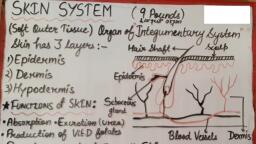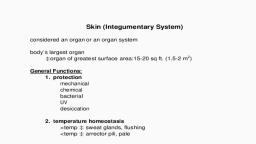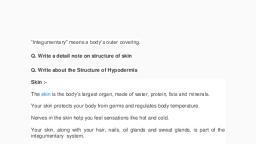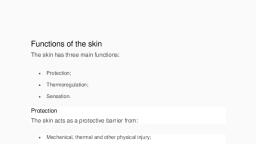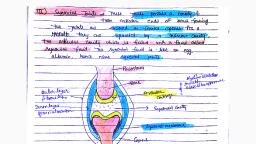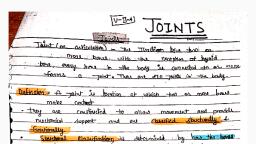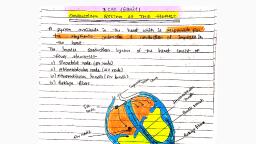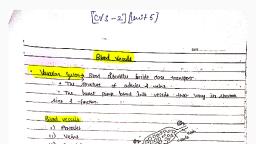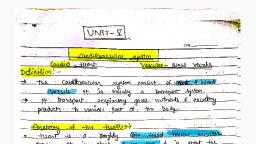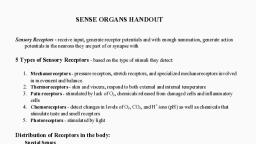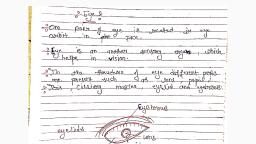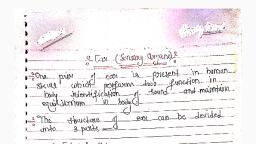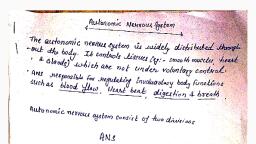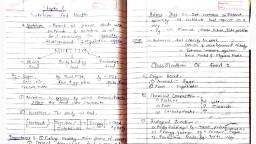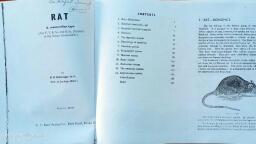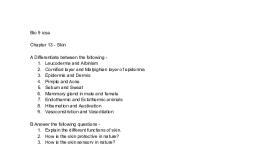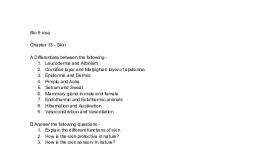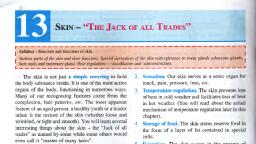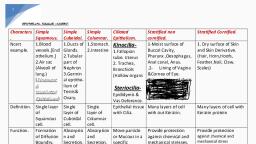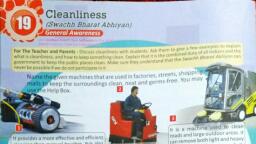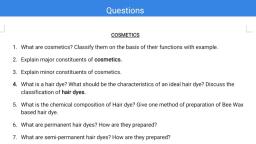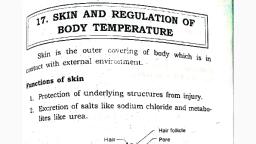Page 1 :
=", I, |, |, I, |, l, I, I, I, I, 1, 1, ], ], ], ], ], ], |, l, I, !, |, I, I, 1, 1, I, 1, 1, I, J, |, I, l, I, |, |, |, |, |, |, |, 1, ], ], 1, J, , Integumentary system, , What is the integumentary system?, , The integumentary system consists of the skin and its accessory structures, including the hair, nails, sebaceous, glands, and sweat glands., , Skin..., , e The skin is the exterior covering of the body., , e |t weighs more than 6 pounds in the average adult, and covers more than 3,000 square inches., It is the largest organ of the body., , e = |tis supplied with blood vessels and nerves., , Functions of skin..., , e The skin provides protection. It protects against invasion by bacteria and other harmful agents., e |t protects delicate cells beneath the surface from injury., , e It inhibits excessive loss of water and electrolytes., , e it produces a protective pigmentation to protect the body against excessive exposure from the sun., e |t helps produce the body’s supply of Vitamin D., , e The skin regulates body temperature., , When the body is too cold, the skin’s blood vessels constrict., , This allows more heat-carrying blood to circulate to the muscles and organs., , When the body is too hot, the blood vessels in the skin dilate., , That brings more blood to the surface for cooling by radiation., , At the same time, sweat glands secrete more sweat that cools the body when it evaporates., , e The skin provides sensations., , e |t contains millions of nerve endings that act as sensory receptors for pain, heat, cold, and pressure., , e Whenstimulation occurs, nerve impulses are sent to the cerebral cortex of the brain... and the brain triggers, any necessary response., , Epidermis..., , ® The skin has two layers... the epidermis and the dermis., , e The epidermis actually has 4 strata..., , e stratum corneum, , 1. The stratum corneum is the outermost strata of the epidermis., , 2. It is mostly dead cells, filled with a protein substance called keratin., , 3. Itis thicker on the soles of the feet than on the eyelids...where there is less pressure., , e stratum lucidum, , 1. The stratum lucidum is a translucent layer lying directly beneath the corneum., , 2. It may not even exist in thinner skin., , 3. Cells in this layer are also dead or are in the process of dying., , e stratum granulosum, , 1. The stratum granulosum is one or more layers of cells starting to die and become hard., , 2. They are in the process of keratinization..., , 3. Becoming fibrous protein similar to that in hair and nails., , e stratum germinativum, , 1. The stratum germinativum is composed of several layers of living cells capable of cell division., , 2. It is the innermost layer of the epidermis, and contains melanin... the pigment that gives color to the, skin., , 3. The more abundant the melanin... the darker the skin color., , ee, , Scanned with CamScanner
Page 2 :
=, |, |, 1, 1, I, I, l, 1, 1, !, I, 1, I, i, J, |, |, ], I, 1, l, l, 1, 1, !, |, I, t, i, I, 1, I, 1], |, q, l, {, |, |, ], ], |, ], |, 1, 1, ], I, J, , 4. Damage to this layer, such as in severe burns, requires skin grafts., , The dermis..., , e The dermis is beneath the epidermis and is composed of connective tissue., , , , , , , , , , , , , , , , , , , , Hair shaft, Stratum comeum, , {harny cell layer), , tratum, germinatwum, , i, (basal cell layer) Epidermis, , Melanacyte, , Sebaceous gland Dermis, , Eccrine, sweat gland, , Subcutaneous, , Apocrine tissue, , sweat gland, , Bicod vessels Connective, , bssué, , Adipose tissue, Arrector pili muscle, , Nerves Hair follicle, , e |t contains the lymphatics, nerves, nerve endings, blood vessels, sebaceous and sweat glands, elastic fibers,, , and hair follicles., , e The dermis is divided into two layers..., 1. The papillary layer is arranged into microscopic structures that form ridges. These are the finger- and, , footprints, 2. The reticular layer is beneath the papillary layer; it is a white fibrous tissue that supports the blood, , vessels, e The dermis is connected to underlying tissue by the subcutaneous tissue., e The subcutaneous tissue or hypodermis is composed of adipose and connective tissue., e Itsupports, nourishes, insulates, and cushions the skin., , The hair..., , e The hair is a threadlike structure formed by a group of cells that develop within a hair follicle or socket., e Each hair has a shaft that is visible and a root that is embedded in the follicle., , e Apilomotor muscle is attached to the side of each follicle., , e It is stimulated by skin irritants, emotional arousal, or cold temperatures, and reacts by contracting., , e This causes goose flesh or goose pimples., , r, ], ], ], 1, I, I, ], l, ll, (|, fl, fl, (, f, [, [, [, f, I, I, q, 0, U, li, q, l, ll, i, q, fl, ll, tl, l, tl, 1, q, q, I, I, q, q, i, tl, fl, fl, fl, ll, f, t, L, , Scanned with CamScanner
Page 3 :
e Atthe base of each hair follicle is a bulb enclosing a loop of capillaries?, e = |tis called the hair papilla, and provides nourishment to the hair., e tis one of the few living parts of the hair, and is responsible for hair growth., , cortex, , , , e The transparent cuticle covers the hair shaft like shingles on a roof, protecting it from the elements and, chemicals, and from losing moisture., , e The cortex provides most of the hair’s weight., , et contains melanin which provides color to the hair, stores oils, provides flexibility and elasticity, and adds, shape to the hair., , e When the cuticle is damaged and exposes the cortex, hair looks dull and dry., , e The medulla is an inner hollow core that runs the length of the shaft., , Sebaceous glands..., , e Sebaceous glands are oil glands., e They have tiny ducts that open into each hair follicle., , |, , _, fl, 1, q, (, i, I, ], Jj, 1, I, I, I, i, t, fl, tl, fl, fl, fl, fl, fl, Ql, t, l, l, I, 1, 1, j, i, J, l, 1, ], I, q, fl, ll, l, I, l, 1, 1, 1, i, ], i, L, , Scanned with CamScanner
Page 4 :
=", |, |, {, I, ll, ll, l, 1, 1, 1, 1, I, i, ], |, ], ], I, l, {, i, |, |, ], 1, !, I, 1, I, 1, q, q, I, l, 1, |, l, ], I, I, |, ], 1, 1, 1, J, , , , , , Hair shaft ———9, ___—- Skin surface, , Sebaceous —, gland, Remnant of inner, root sheath, Outer root sheath, , e ach sebaceous gland secretes sebum, which lubricates the hair and skin., e The amount of secretion varies with age, puberty, and pregnancy., , Nails..., , e Fingernails and toenails are hard keratin structures that protect the ends of the fingers and toes., , @ The nail root, also called the germinal matrix or nailbed, begins several millimeters into the finger and, extends to the edge of the white, crescent-shaped lunula., , e This is where the growth occurs... approximately 1 mm. per week., , , , , , , , , Cuticle, , Nail plate, , Lunula, , Cuticle Proximal nail fold, , Nail plate, , Nail matrix, , Hyponychium, , Nail bed, Nail root, , e The under-surface of the nail plate or body of the nail has grooves that help anchor it., , The cuticle is also called the eponychium., , It fuses the nail plate and the skin of the finger together to form a waterproof barrier., , The hyponychium is under the free edge of the nail., , It also creates a waterproof barrier, fusing the skin of the finger to the underside of the nail plate., A lost finger- or toenail will regenerate., , a, , Scanned with CamScanner
Page 5 :
Hee en ee ee ie ee ee ee ee ne, , Ingrown nail..., , e Ingrown nails are simply those that have curled down or around and are growing into the skin., , , , , , , Ingrown, toenail, , , , , , e They may become swollen and inflamed. Trim toenails straight across to avoid this growth pattern., , Sudoriferous Glands (Sweat Glands)..., , e Sudoriferous glands are sweat glands., e About 2 million are distributed over the surface of the body, more numerous on the palms of the hands,, soles of the feet, forehead, and axillae or underarms., , , , , Epithelial, cells of a, sweat gland, , , , , , e Sweat glands produce sweat or perspiration. As sweat collects on the skin surface, it evaporates and creates, a cooling effect. Sweat also rids the body of waste through the pores of the skin., , e Asit accumulates, sweat may become odorous by the action of bacteria., , e The average person loses approximately % liter of fluid through sweating each day., , , , Scanned with CamScanner
